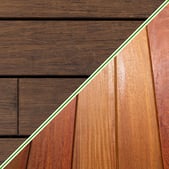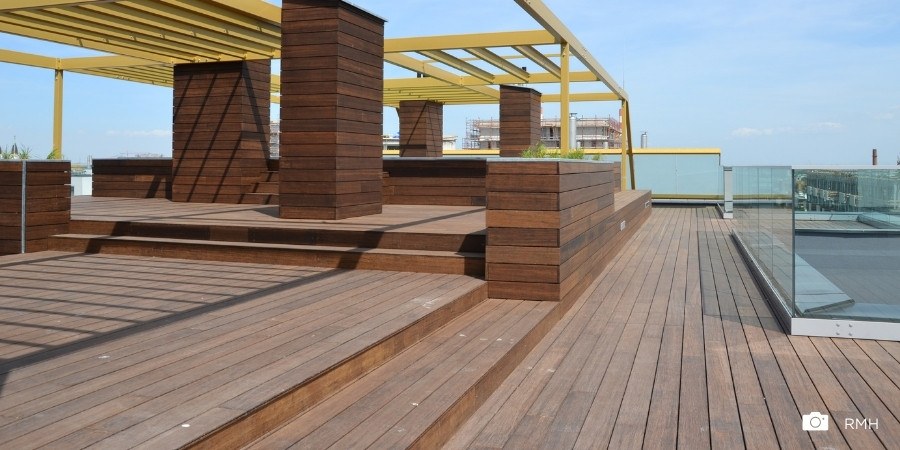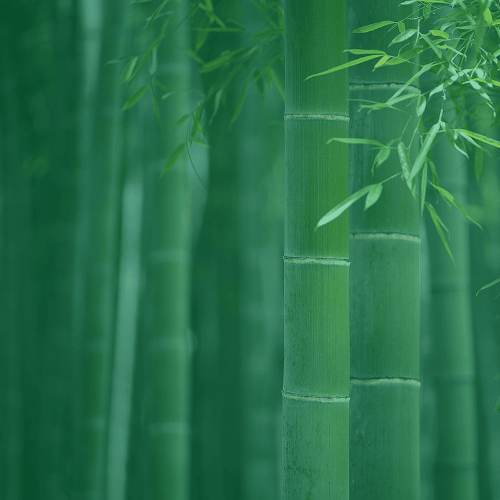Bamboo decking or deck boards are becoming more and more popular. However, not everyone is convinced of bamboo as an alternative to hardwood or composite. It’s time to list the pros and cons of bamboo decking.
Advantages of bamboo decking boards
- Long service life
- High stability
- Environmentally friendly
- Natural look
- No visible fastening
Disadvantages of bamboo decking boards
- Price
- Relatively heavy
- Production in China
- Only available in one colour
- Maintenance
Use our comparison tool to compare bamboo decking with wood, composite or plastic decking for a terrace.
The five main advantages of bamboo deck boards
- Long lifespan
- High stability
- Environmentally friendly
- Natural look
- No visible fastening
More and more architects, homeowners and project developers are discovering bamboo. Its natural look and durability are important advantages. Moreover, bamboo can be used both indoors and outdoors. Bamboo flooring, bamboo cladding and bamboo furniture are just a few of the possible applications. In addition, the popularity of bamboo decking boards for terraces, stairs and walkways is growing. And that is not without reason.
1. Long lifespan bamboo decking
The main advantage of bamboo decking is its long service life. The lifespan of natural bamboo decking is comparable to high quality hardwood, such as ipe, and the MOSO® Bamboo X-treme range even comes with a guarantee period of 25 years.
2. High stability
Wood deforms under the influence of moisture. When wood becomes damp it expands and can crack, when dry it shrinks. The extent to which it reacts is different for each type of wood. Soft wood decking boards, such as pine and spruce, sometimes expand by up to 10%, while bamboo is known for its high stability. Only hardwood, and more specifically ipe, come close to bamboo on this matter. The high stability of bamboo decking has, among other things, the advantage that the boards remain beautiful for a longer period of time and can be installed in clean patterns. In addition, the end-match system at the ends allows for the boards to be installed together without a gap, which definitely enhances the appearance of the terrace.
3. Environmentally friendly bamboo decking boards
Bamboo grows faster than any other plant and can grow up to 20 metres high. It takes about 4 to 5 years before bamboo can be harvested. With hardwood, this is often only the case after 50 to 100 years, which means there is a high risk of deforestation. Bamboo is virtually inexhaustible, stores a lot of CO2 and is therefore an environmentally friendly alternative to materials such as composite and plastic, but also to tropical hardwood. Read more about environmentally friendly bamboo deck boards.
4. Natural look and feel
Bamboo decking gives a natural look to a garden or terrace in contrast to the use of, for example, plastic or composite. Wood and also bamboo provide a sense of peace and ambiance, they are timeless and create a warm appearance. Browse through countless inspiration projects to see how bamboo decking looks in real installations.
5. No visible fastening
Due to the high stability of bamboo decking boards, only little space is needed between the boards. In addition to this, bamboo decking boards can be fitted with special fasteners so the fastening of the boards is not visible.
Our comparison tool helps you compare different options for decking boards by comparing their pros and cons.
The five main disadvantages of bamboo decking
- Price
- Relatively heavy
- Production in China
- Only available in one colour
- Maintenance
In addition to the advantages of bamboo decking, there are also some disadvantages. For example, high-quality bamboo does not come cheap and the decking boards are available in a single colour. Additionally, bamboo decking boards are relatively heavy, something that must be taken into account when creating the substructure. Other objections mainly arise from ignorance about the product. After all, ignorance is a bliss. That is why the disadvantages of bamboo decking boards deserve some extra explanation.
1. The price
Quality comes at a price. Bamboo is not cheap, certainly when compared to softwoods and decking of lesser quality hardwoods. The same applies when compared to composite and synthetic decking. However, the price of bamboo decking is about the same as decking boards of a good quality hardwood. As a result, bamboo and good hardwoods are often considered to be exclusive. In addition, bamboo decking boards last up to 15 years longer than, for example, softwoods.
2. Relatively heavy
Bamboo decking boards are supplied in a length of 1.85 metres, while hardwood is often as long as 5 to 6 metres. This is not a disadvantage when transporting the boards and therefore the weight of a loose bamboo decking board is on average 5 to 6 kilograms. But compared to wood and plastic, bamboo decking boards are relatively heavy. For a garden or terrace this usually does not cause any problems, but for a roof terrace or balcony it can cause problems. Therefore, initial calculations regarding whether the roof or balcony is suitable to bear the weight of the decking is necessary, as is necessary with terrace tiles. Additionally, always ensure a good substructure for a bamboo terrace.
3. Production in China
Unfortunately, most of the bamboo for the production of bamboo decking does not grow in Europe or North America, but in China. As a result, many are worried about CO2 emissions, the working conditions in the factories and the quality of the product. As not all producers of bamboo decking boards have the same strict quality and environmental requirements, it is important to pay close attention to the labels and certifications.
MOSO® Bamboo has conducted several LCA reports to evaluate the CO2 footprint of bamboo. This shows that MOSO® Bamboo X-treme Decking is CO2 neutral during the product lifespan. The amount of CO2 that bamboo absorbs during growth is more than the emission of CO2 due to production and transport.
4. Only available in two colours
Bamboo decking boards are only available in one colour for the time being. The boards will change colour after installation, due to UV radiation, from brown to dark brown during installation to grey a few months later. Without maintenance, the aging will continue. After about 3 months, however, it is possible to treat the decking boards with oil, providing them with the desired colour. Browse through countless inspiration projects to see how bamboo decking looks in real installations.
5. Maintenance
Wooden decking boards require maintenance. This certainly applies to bamboo decking boards as well. This is the only way they can withstand intensive use, water and different types of weather conditions. By regularly cleaning and oiling the decking boards (MOSO® Bamboo advises to do this annually) bamboo decking boards retain their excellent quality and beautiful appearance. Read this blog about how to maintain a bamboo deck.
Bamboo decking has both advantages and disadvantages. In contrast to the natural look and the long life span of bamboo, the relatively high price and the necessary maintenance of bamboo decking are some of the disadvantages. If you strive for the very best, then bamboo decking is definitely a good option. If, unfortunately, your budget is not as high, you will have to make concessions and perhaps look at composite, plastic or settle for a lower quality wood species.
 Would you like to compare bamboo decking with hardwood, composite or plastic? Use our comparison tool to make the right choice.
Would you like to compare bamboo decking with hardwood, composite or plastic? Use our comparison tool to make the right choice.










%20Picture%20by%20Tim%20Baynham%20-1.jpg?width=600&height=300&name=2021006%20LR%20(20)%20Picture%20by%20Tim%20Baynham%20-1.jpg)
